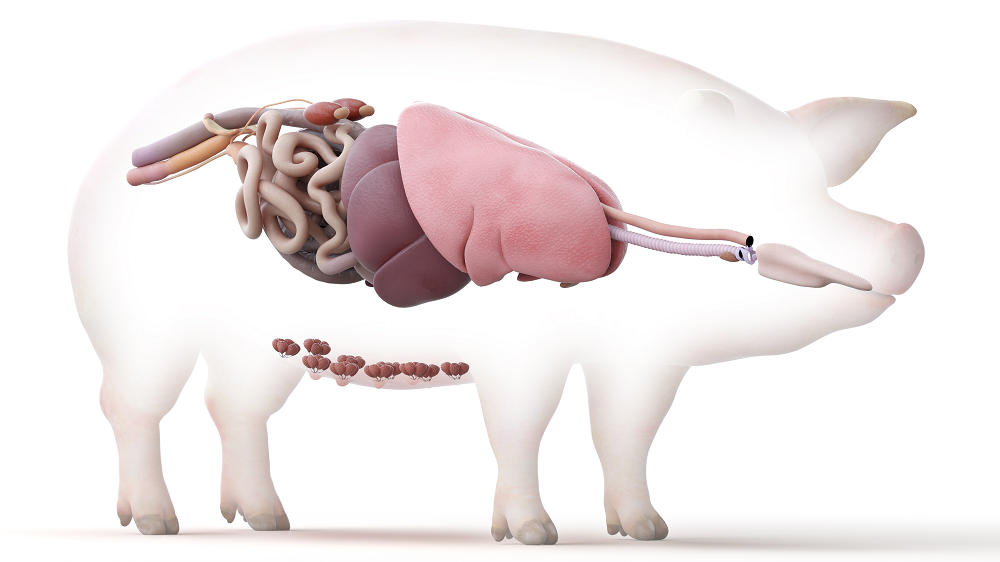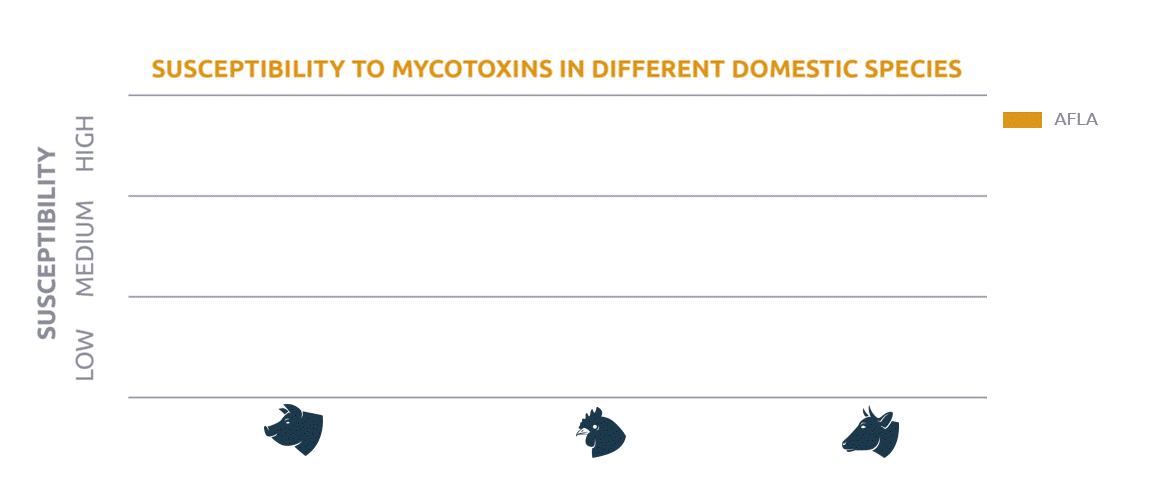Mycotoxins are secondary metabolites produced by fungi that grow on grains like corn, wheat, and sorghum. This growth can occur at or before the harvest, during storage, or even in the animal feeder. When consumed by domestic animals, these fungi metabolites are highly toxic. Some better-known mycotoxins are aflatoxins, fumonisin, ochratoxin, trichothecenes, deoxynivalenol, T-2, ergot, and emerging toxins. There is also growing evidence on the role of bacteria-produced endotoxins in swine.

Aflatoxin
Deoxynivalenol
Fumonisin
T-2 & HT-2
Fumonisin
Fumonisin
T-2 & HT-2
Zearalenone
Ergot alkaloids
Ochratoxin
Aflatoxins
Ergot alkaloids
Ergot
Deoxynivalenol
T-2 & HT-2
Aflatoxin
Aflatoxin
Deoxynivalenol
Fumonisin
T-2 & HT-2
Fumonisin
Fumonisin
T-2 & HT-2
Zearalenone
Ergot alkaloids
Ochratoxin
Aflatoxins
Ergot alkaloids
Ergot
Deoxynivalenol
T-2 & HT-2
Aflatoxin
In the domestic pig’s diet, most of the grain fed is corn, sorghum, and wheat, which means pigs are frequently exposed to toxins. Feed with elevated mycotoxins levels has a peculiar flavor, look, and taste. With higher sensory perception than humans, pigs are cautious if something is wrong with the feed (like the presence of mycotoxins) and will refuse to eat if they perceive it as dangerous. This is why it is not common to see acute intoxication in swine. However, in pigs, gradual intoxication is typically observed because the animals eat sublethal doses for an extended period. Toxicity in pigs affects health status, productive performance, and growth rate.
In swine, it is common to find clinical cases due to feeding contaminated with mycotoxins everywhere in the world. However, most reported clinical-level illnesses are from controlled experimental intoxication. In these trials, the type of mycotoxins and quantities are known. By contrast, in field cases, it is assumed the animal has ingested subclinical amounts of toxins over a long period, with some mycotoxin quantities reaching higher levels to cause problems. In addition to the damage caused by mycotoxins, it is common to see clinical infectious diseases as a comorbidity due to the immunosuppressive effects of most mycotoxins. This harm to the animal’s performance is why rapid identification of the signs and lesions from mycotoxins can help to control intoxications before they cause irreversible damage to the animals.

Clinical signs and lesions observed in pigs
| Endotoxins | FUM | ZEA | DON | T-2 | OTA | AFLA | Ergot | |
|---|---|---|---|---|---|---|---|---|
| Sudden death | + | +++ | + | + | ||||
| Anorexia | ++ | + | +++ | ++ | + | + | + | |
| Growth retardation | +++ | ++ | + | ++ | + | +++ | ++ | |
| Hepatic lesion | ++ | ++ | + | + | +++ | ++ | ||
| Kidney damage | ++ | + | +++ | |||||
| Pulmonary Edema | +++ | |||||||
| Heart damage | + | ++ | ||||||
| Abortion | ++ | +++ | + | ++ | ||||
| Infertility | ++ | +++ | + | |||||
| Vulvovaginitis | +++ | |||||||
| Gangrene | +++ | |||||||
| Immunosuppression | +++ | + | ++ | +++ | + | +++ | ++ |
| Table: Clinical signs and lesions observed in pigs |
Naturally present in the gut and, once excreted, found in dust particles, liposaccharides (LPS) effect on swine production comes from the inflammatory reaction of endotoxins. As a result, we can observe respiratory or gastrointestinal diseases affecting the animals that either inhaled them or have a high population of gram-negative bacteria in the gut.
First, the gastrointestinal barrier alters due to the inflammatory response. A study on the effects of endotoxins on the morphology of the gastrointestinal gut barrier showed that LPS decreased the height and area of intestinal villi, increased the width of the villi, and increased the depth and width of the intestinal glands. The authors concluded these effects contribute to decreased intestinal nutrient absorption and increased co-infection with other pathogens, leading to post-weaning diarrhea syndrome.
Second, initiated by exposure to endotoxins, fever is mediated through IL-6. Other symptoms are mediated through the action of the different cytokines, but all are related to the inflammatory response. As a result of inflammation, endotoxemia leads to a feverish state that results in reduced feed intake.
Finally, with the activation of the inflammatory system, there is a nutrient expense that results in a lower feed conversion rate (FCR) and decreased growth performance.
Fumonisin B1 reduces lipid metabolism and primarily targets the lungs and liver. The kidneys and esophagus might also be affected in swine. Typically, the first sign of this toxin is dyspnea (shortness of breath or panting) which can lead to respiratory failure and, in severe cases, death within a few hours. Fumonisin B1 typically occurs in pigs fed corn deemed unsuitable for human or poultry consumption.
Pulmonary edema is the most consistent lesion found in pigs intoxicated with this mycotoxin. Also observed is enlargement of the lungs, liver, and heart.
It is important to know this mycotoxin can be excreted via milk and piglets can show growth retardation.
Resembling oestradiol, zearalenone (ZEA) has estrogenic effects on sows to decrease reproduction abilities. Signs of this toxin include degeneration of blastocysts, reduced number of piglets per litter, abortions, low conception rate, increased stillbirths, inactive corpora lutea, hydrometra, ovarian cysts, splayed leg, trembling piglets, sows with vaginal discharge, as well as rectal and vaginal prolapse.
In boars, ZEA affects the semen quality and is known to cause increased nipple size (gynecomastia) and more prominent sex organs.
Zearalenone is also found in milk and can be ingested by piglets to cause swelling and redness of the vulva.
With more than 150 different trichothecenes isolated, this group includes several mycotoxins linked from the structural point of view but may differ in both the origin fungus and impact based.
Trichothecenes typically affect the central nervous system’s regulation of appetite control, increase amino acids circulating in the blood, raises tryptophan levels in the brain–which raise serotonin levels (high serotonin levels produce the perception of satiety)–and inhibit protein synthesis in the liver.
The trichothecenes toxins most reported in swine cases are deoxynivalenol (DON) or vomitoxin, nivalenol, 15-acetildeoxynivalenol, and T-2 & HT-2. Generally these toxins are very aggressive to the digestive tract epithelium and result in the most common signs of vomiting or feed refusal, but this does not happen in all cases.
In vivo and in vitro studies performed with DON showed an increase in the expression of proinflammatory genes. In addition to altering the intestinal barrier function, DON can induce gastrointestinal inflammation and necrosis within the intestinal tract. In this way, deoxynivalenol allows the entry of opportunistic germs capable of causing infections.
Pigs are very susceptible to the effects of T-2 and HT-2 toxins. The mycotoxin HT-2 is considered the deacetylated form of T-2 and is created in the intestine when the T-2 toxin is metabolized. Therefore, T-2’s toxin effects can be partially attributed to HT-2.
The signs and lesions are very similar, T-2 and HT-2 inhibit protein and RNA/DNA synthesis to induce apoptosis and necrosis. The toxins typically cause lesions in the upper gastrointestinal tract, resulting in oral mucosa, hemorrhages, and skin inflammation. In high concentration situations, diarrhea and perianal lesions occur with the residual toxins in the feces. In these situations, the toxins can have direct action through the lesions without needing metabolic activation.
Like other toxins, T-2 metabolites can be detected in sow milk and in the stomach contents of piglets. Piglets will show diarrhea and emaciation before coma and death within the first days after birth.
Ochratoxin A (OTA) and citrinin are nephrotoxic (kidney damaging) and affect renal function. The pathological effects of OTA and citrinin are similar, and it is possible that lesions observed in research are due to the action of both. However, OTA is regularly detected in mycotoxin analyses of suspicious feed, indicating it is the more common of the two. Stability-oriented studies of OTA on its duration of activity shown the toxin to be highly stable, therefore, the damage in tissues is often the result of accumulation.
Similar to aflatoxins, these mycotoxins have carcinogenic, teratogenic, and immunotoxic effects. Indicative signs reported with ochratoxin are polydipsia and polyuria. However, the clinical signs are not easy to register in pigs that consume water ad libitum and are raised on cement floors. Growth retardation is also regularly observed.
In postmortem examinations of animals presumed to be affected by OTA, the renal lesions observed macroscopically were described as, “white patches on the surface of the kidney which varied in size from a diffuse stippled to irregularly shaped spots easily distinguishable” as well as containing, “cysts both individually or multiple in the same kidney”.
Aflatoxins have a devastating effect on the productive performance of pigs. The most notable clinical signs in animals affected are a slow growth rate and a yellowish (icteric) color in both the skin and hair. The mode of action of aflatoxins results in the metabolites targeting the liver by inhibiting DNA and RNA synthesis and reducing enzyme activity. This impact on liver function is sufficient to explain the jaundice that manifests as a yellow pigment in animal tissues.
The same coloring is observed in postmortem examinations in the skin, subcutaneous tissue, muscle, and liver; fat changes are also present. In chronic cases, the liver shows fibrosis—scarring and stiffening of fibers. In the stomach, gastric ulcers and reduced spleen size are occasionally observed and can be related to immunosuppression.
Aflatoxin B1 impacts piglets via transfer by the mother as aflatoxin M1 is present in the milk, delaying piglet growth.
Ergot bodies, also known as sclerotia, are growths from specific fungi, particularly C. purpurea. Within these ergot bodies are alkaloids that are potent initiators of smooth muscle contraction of the uterus and the middle layer of the arteries.
These alkaloids also simulate the action of dopamine in the central nervous system and inhibit prolactin release, preventing the growth of the mammary gland and inhibiting lactation. The alkaloids, in high concentrations, cause constriction of the arteries to result in possible abortion, ischemia, dry gangrene, and necrosis in the limbs and appendages (exacerbated in cold climates). This toxin also causes liver damage, polydipsia, and polyuria.

Would you like to be kept informed of our latest developments? Register here and stay up to date.
"*" indicates required fields
| Cookie | Duration | Description |
|---|---|---|
| cookielawinfo-checkbox-analytics | 11 months | This cookie is set by GDPR Cookie Consent plugin. The cookie is used to store the user consent for the cookies in the category "Analytics". |
| cookielawinfo-checkbox-functional | 11 months | The cookie is set by GDPR cookie consent to record the user consent for the cookies in the category "Functional". |
| cookielawinfo-checkbox-necessary | 11 months | This cookie is set by GDPR Cookie Consent plugin. The cookies is used to store the user consent for the cookies in the category "Necessary". |
| cookielawinfo-checkbox-others | 11 months | This cookie is set by GDPR Cookie Consent plugin. The cookie is used to store the user consent for the cookies in the category "Other. |
| cookielawinfo-checkbox-performance | 11 months | This cookie is set by GDPR Cookie Consent plugin. The cookie is used to store the user consent for the cookies in the category "Performance". |
| viewed_cookie_policy | 11 months | The cookie is set by the GDPR Cookie Consent plugin and is used to store whether or not user has consented to the use of cookies. It does not store any personal data. |
